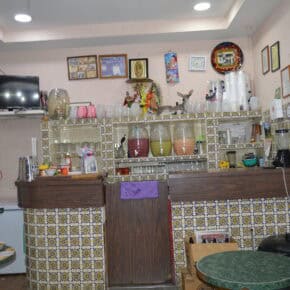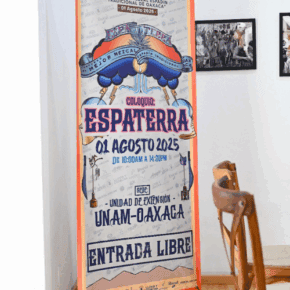This is a cross post from one of our frequent collaborators, Ferron Salniker. You can read her excellent blog Ferronlandia here. This piece was originally published on 4/15/16. You can read the original here.
Max Rosenstock is from New Mexico, lives in the Bay, and knows the Oaxacan countryside so well I’m surprised when he hits a tope too fast. His project, Neta Mezcal, is soon to officially launch in the U.S.— and in the meantime he’s been traveling Oaxaca for years finding good mezcal. He reminds me of my Bay boy friends because he’s all brains and jokes under a hoodie and baseball cap, but unlike most of my friends, when Max rides up he’s got a trunk full of exceptionally good mezcal, ceramics and textiles. (I would like more friends like this). Here are some notes from heading to palenques with him.
Tlacolula & San Baltazar Guelavia
In January, Max invited my boyfriend and I along to San Baltazar Guelavia to visit mezcalero brothers Leonardo and Aureliano Hernandez. On the way we stopped at the Sunday Tlacolula market for some barbacoa and grabbed some chorizo and tasajo (thinly pounded air-dried beef) to go. The Tlacolula market is one of the biggest in the area, the walk in alone a maze of tropical fruit, leather belts, hanging bulbs of chorizo and live animals.
Once we got to San Baltazar the family brought out beans straight from the ranch, put piles of guajes on the table (tough purple pods with bright green seeds that have been a tasty supplier of protein in Oaxaca for a very long time), and threw the meat on the grill. The palenque sits on the edge of a hill overlooking the town, and we hailed a tortilla truck from across the valley.
Afterwards, we tried many jicaras of mezcals. There was a tall, bearded white man who I thought maybe dropped down from outer space, but he’s been living in Mexico and working in *various agriculture fields* long enough to have jokes about embarrassingly offending people with his rudimentary Zapotec and Spanish.
I always try and keep notes when tasting mezcal, but in the end they turn to scribble. As I remember, there were a lot of different agave varietals here and I loved the coyote and barril, both so balanced and unique but without the slap in the face I feel with some of the other varietals. We drank more, the jokes got better, and as the long afternoon went on, I got pretty good at opening up the agave seed pods laying on the ground.
Only a small percentage of Neta’s mezcal will be coming from this area, most of it will be from the Miahuatlán and Ejutla areas, with a small percentage from Santa Catarina Minas. So, onto Minas.
Santa Catarina Minas
This last trip to Oaxaca I tagged along with Max to Santa Catrina Minas and San Vincente de Coatlan. In Minas we visited the palenque of Felix Ángeles Arellanes, at the convergence of the Ejutla and Mihuatlán valleys, which makes for an interesting mix of agaves.
Arellanas spent ten years installing sprinkler systems in California before returning to his native Minas to pick up his dad’s mezcal business (after his dad was gorged by a bull). He has nine children, most helping with the production. Next to his house the palenque has three stills and fermenting tanks, and a blue and white alter in the corner. A grinder sits in the shade, not used much as he prefers to hand mash the agave.

He only had a liter or so of pechuga left. A tripon was fermenting to be ready next week and a marteño with a chocolatey finish had just finished yesterday. I walked away with an ensamble (mix) of cierrudo, arrequeño and espadin. If you don’t know what any of those mean, I feel you bro. Mezcal is made out of many species of agave with varietals and sub-varietals, including some that are sometimes called different things but actually the same. Keeping track can get confusing.
But what actually bothers me about mezcal is not that I need flashcards to keep track of what I’m drinking, but the romanticism involved in the marketing of mezcal. When I hear about a bottle of mezcal being handmade, I think about Felix mashing a pile of agave with a giant wood club for eight hours, and it sounds fucking exhausting. A traditional craft is beautiful, but the truth is that it’s also hard, sweaty, and often doesn’t come with enough financial rewards. But people continue because that’s the option.
“After some drinking I’ve had mezcaleros cry in front of me telling me how hard it was when they were younger, going up to collect agave with nothing to eat for days,” said Max. Felix didn’t open up much, but he did say that these days things are much better than they’ve ever been for his family.
Another truth is that in Oaxaca many of the same areas producing mezcal are also entrenched in the drug war. But If I didn’t have Max filling me in on agrarian conflicts and explaining how changes in the U.S. drug market have directly influenced what’s happening in the towns we’re driving through along the pothole-covered “new” Puerto Escondido-Oaxaca highway, I wouldn’t know much about it or how to talk to mezcaleros about it. As a visitor here, even one that speaks Spanish and asks questions, you can easily get swept up in the mezcal bars and colorful walls and fireworks of Oaxaca city, and not dig deeper into why there are at least 20 police trucks trolling Miahuatlán on market day.
“Because there was a venganza last week,” said one of the federales that stopped our car when I was on a different visit with another friend. Venganza means a revenge— a homicide over some drug related conflict. While I obviously don’t expect mezcal brands to tout the proximity of their product origin to poppy fields and murders, hearing about the real context of a mezcalero’s surroundings only makes me respect them and their work more.
I think it’s Max’s genuine interest in Oaxaca and the people making mezcal that’s allowed him to form real relationships with mezcaleros around the state (by now I can probably recite many of their names, their health problems, dishes they’ve made him and the family drama). On a lighter note, it also means he knows where the good snacks are.
San Vicente de Coatlán
On our way to our second stop we hit a very small town off the highway called San Martin de Los Consecos for goat cheese. The first house had lots of goats spilling out into the streets, but no cheese. A seven year-old pointed us in the right direction, and from the outside of a baby blue fence, a woman brought us a ball of cheese in a plastic bag. It was salty, but made a great complement to the lengua cold cuts and baguette we had in the car.
In San Vicente we went to the house of the Buenaventuras. There a father and his sons make a fragrant espadin, a madrecuixe that tastes like wet rocks, a fruity mexicana, and a san martin that takes 16 years to mature.
The women of the household, Zenaida and her mother Tomasa (who speaks very little Spanish) make beautiful textiles.
Like mezcal, the blouses made here are a labor of love and take anywhere from three to six months to make. It took me about five minutes to buy two.
A pair of giant pigs, goats, turkeys, chickens and a donkey live out back. They’re growing espadin on their land, as well as rotating corn and beans.
Zenaida and the three kids showed me around before we left, giving me a handful of bright pink prehistoric looking flowers from the garden and a tiny blouse that she said could be for my future baby or a doll. Naturally, I put it over a plastic bottle of mezcal like a koozie.

Later in Miahuatlán we walked the market, Max picking up the ingredients for his version of a banh mi sandwich and me grabbing a bag of tiny red heirloom tomatoes that grow in the region. I took a bus back to Oaxaca city, watching the sunset and the cacti that reach up like twisted candelabras. He headed off to another palenque.






























OMG! I also visited the Arellanes palenque a few weeks ago! I picked up a bottle of ensamble (espadín, sierrudo, arroqueño and madrecuixe) and a super fragrant tobala. As you mentioned, incredibly humbling to see the work and toil behind the marketing.